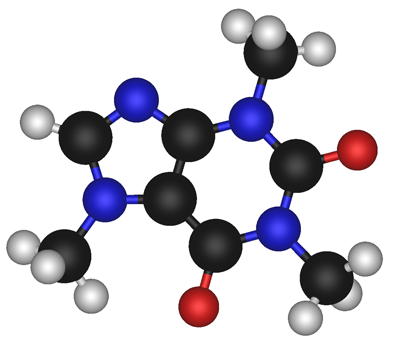Introduction
Overview | Making Connections | Building in the Game
Overview
 Caffeine molecule, photo from Ronhjones via Wikipedia Commons
Caffeine molecule, photo from Ronhjones via Wikipedia Commons
When you build a structure, whether a small stack of building blocks or a skyscraper, there are certain rules you follow. There are ways to connect materials safely, and ways to build a structure that can stand up to forces like gravity. Each molecule in all the materials around us also follows a set of rules. The way they interact with other molecules and atoms is predictable. We can also predict how they respond to certain environments.
Our knowledge of these rules allows us to use some molecules as tools. It lets us predict how some molecules or materials might interact or attach to each other. Using tiny materials like molecules and atoms to build things has a special name. Think of it as engineering at the “nano” scale, or nanoengineering. There’s also a type of nanoengineering that uses materials that are a part of living systems. “Bio” means “life,” so when we build with parts of living tissues we add “bio” to the name. Using parts of living tissues to build tiny things is called “bionanoengineering.”
Making Connections
 Oil (top layer) and water (bottom layer) don’t mix.
Oil (top layer) and water (bottom layer) don’t mix.
The rules you will be using to play Nano Building may seem simple. Colors connect to like colors, and don’t connect to other colors (with a few exceptions). But the shapes that you can build with just a few simple rules can get very complex. And the same is true for molecules.
Some parts of certain molecules are drawn together by forces that work on a tiny scale. Other parts of molecules will never connect to each other. A lot of this is controlled by two main forces: electrostatic and hydrophobic.
Electrostatic forces can be thought of as similar to the poles of a magnet. Certain parts of a molecule might be attracted to one another. Other parts might repel each other, due to their electrostatic forces.
Another force is the “water-fearing’ force. Hydro- (water) -phobic (fearing) forces are due to the “dislikes” of fatty molecules. Fatty molecules tend to not like water molecules. They are attracted to one another and will try to avoid water molecules. This might make you think of the saying that oil (a fatty substance) and water don’t mix.
Building in the Game
 Simple rules build complex shapes!
Simple rules build complex shapes!
In Nano Building, these rules are simplified to focus on colors. Two blocks that are different shades of the same color can attach to one another. Two blocks of the same exact color won’t attach. There are also a few additional rules for grey, black, and white blocks. If you want to go through and learn all the rules, use the How to Play and Tutorial pages to help you get started. Otherwise, feel free to jump into the game and start playing around. There are four levels of difficulty that you can play to try to solve specific challenges. Or, if you want to try to build your own shapes, you can play in our “sandbox” building section. Happy Nano Building!